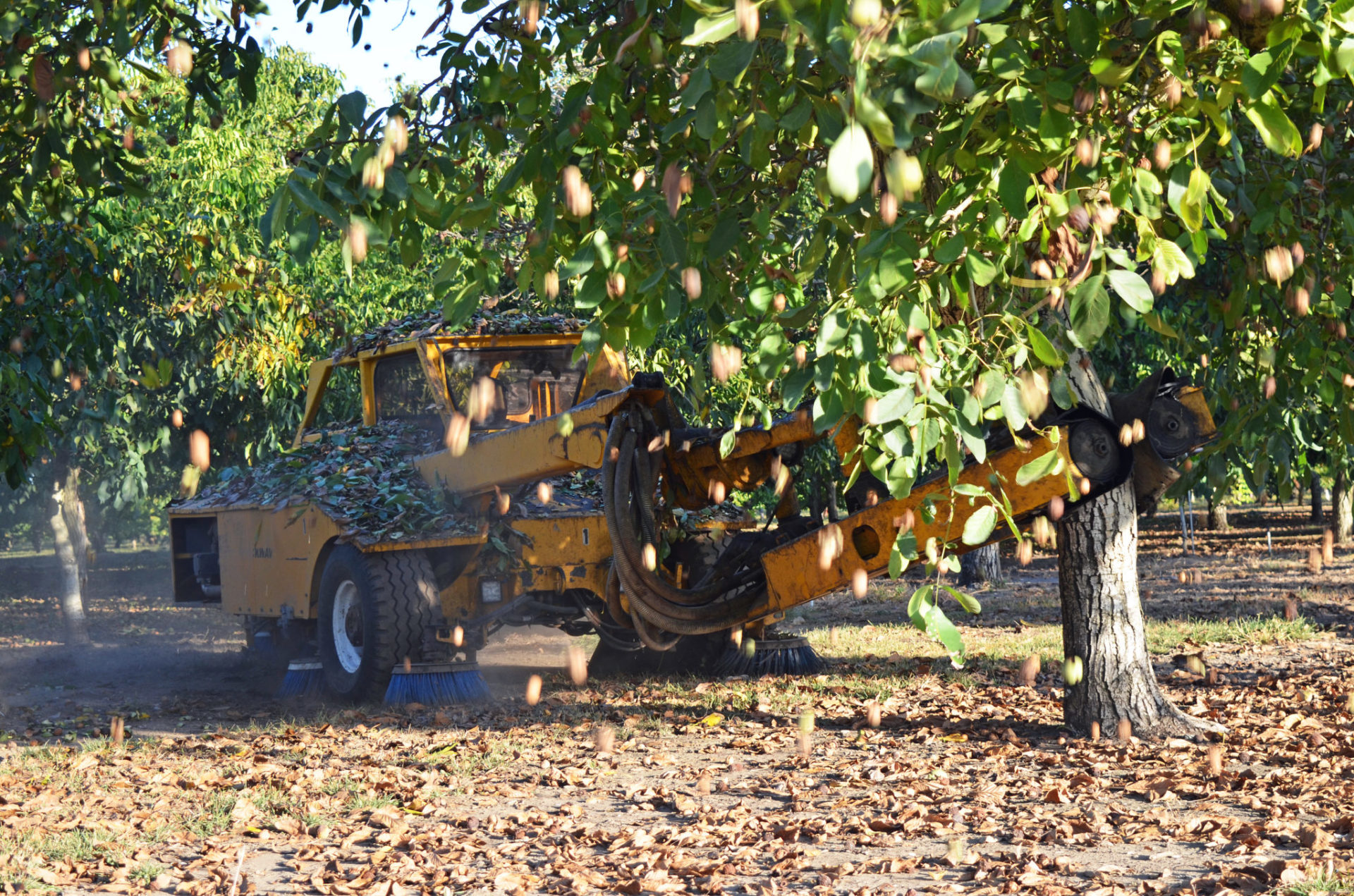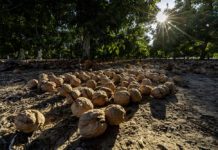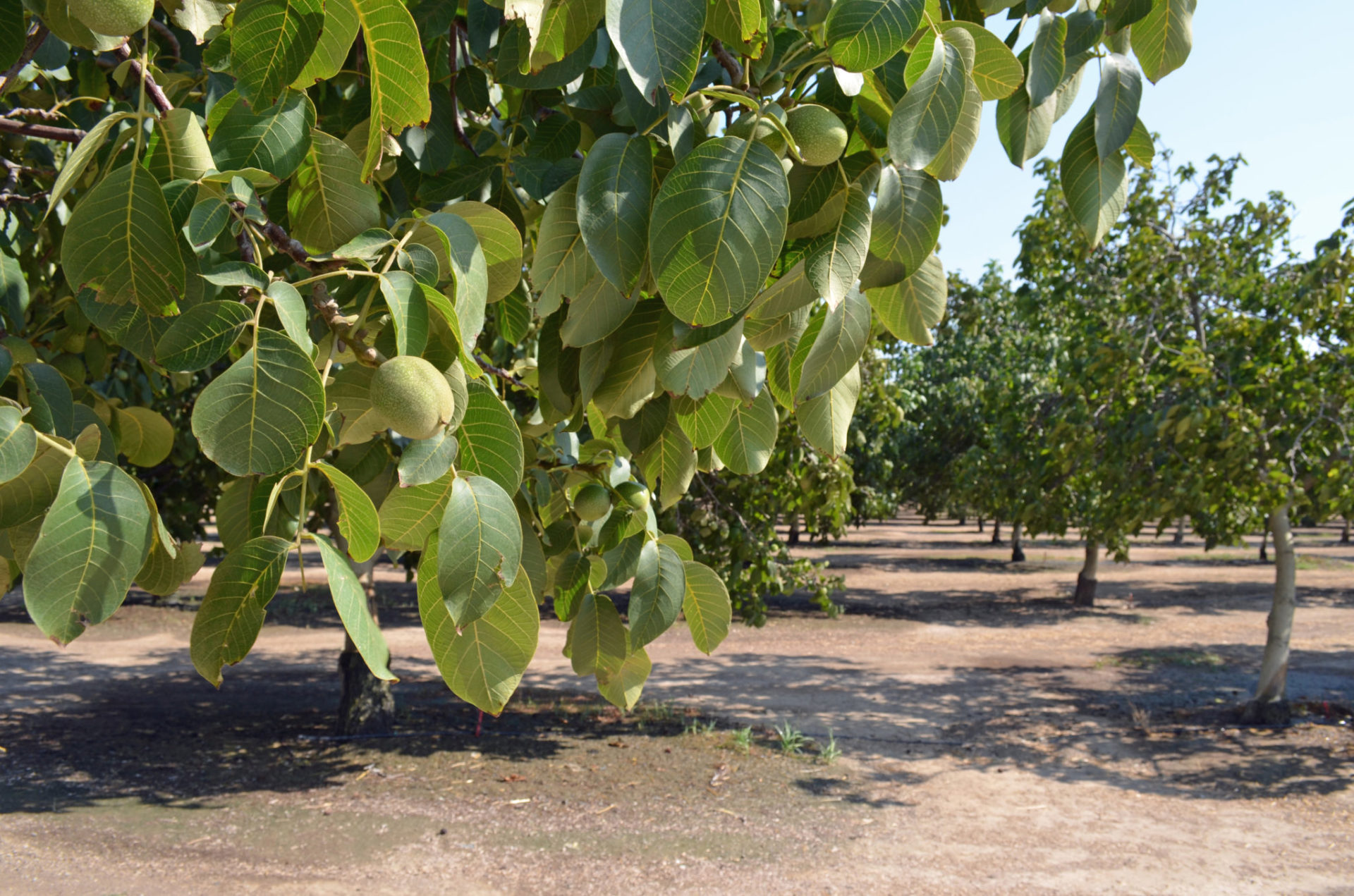
Successfully using the plant growth regulator (PGR), ethephon, to potentially hasten walnut harvest or improve nut removal and hullability has been described as part art and part science.
To obtain the desired results, growers first need to determine if walnut kernels are mature and receptive to the PGR by accurately sampling the orchard. Then they must factor in other variables, such as variety, tree stress levels, weather conditions, harvest equipment availability and whether the huller/drier they deliver to is ready to receive their nuts, said Bob Beede, University of California Cooperative Extension farm advisor emeritus for Kings County.
Ethephon can be used in two ways, based on a grower’s goals. If it is applied when at least 95% of the kernels are mature, it can promote an average of four to five days earlier harvest, depending on the season. This may help the grower harvest more desirable lighter-colored kernels while potentially minimizing navel orangeworm exposure, he said. If done correctly, using ethephon this way could potentially net a grower an average of 5 cents per pound more.
A PGR application made five to seven days after 95% kernel maturity may aid nut removal and reduce the chance of having to shake a second time. Regardless of their choice, Beede said, growers need to begin by assessing nut maturity.
“One of the key elements to using ethephon is to accurately determine the physiological stage of what’s known as packing tissue brown, or PTB,” said Beede, who has conducted numerous trials with ethephon during his tenure. “It doesn’t simply mean talking to your friends or going to the coffee shop and asking people when they’re putting on their ethephon because trees in sandy soils often times will mature sooner than trees on heavier ground. Water stress and high nitrogen also affect PTB.”
A plant growth regulator, ethephon boosts the release of the plant hormone ethylene, which promotes ripening and senescence.
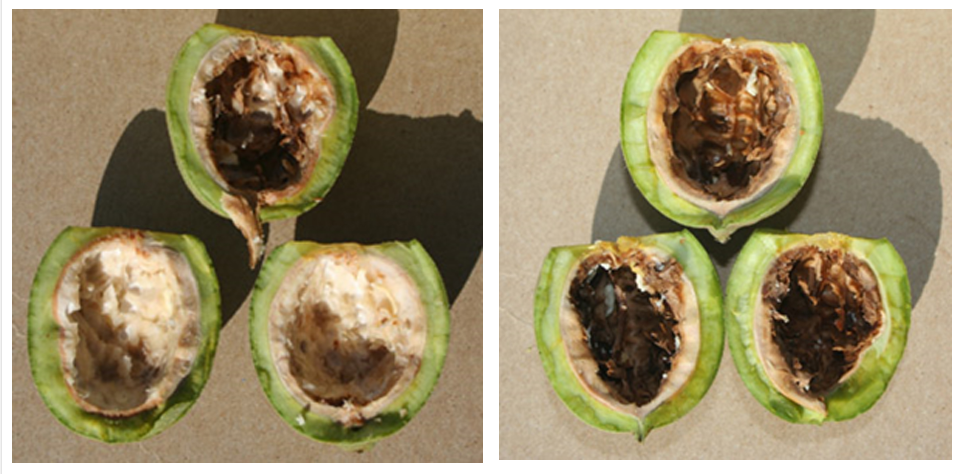
Sampling for PTB
Walnut kernels reach peak maturity and maximum oil accumulation when the PTB has changed from a bright white to an oak-brown color. At this stage, the kernels are the coveted light blond color. While growers wait for hull split and eventual harvest, the PTB continues to darken as does the kernel.
Kernel maturity typically occurs up to 21 days before an untreated harvest but may occur later in well-irrigated and/or heavily fertilized orchards.
Start sampling about two weeks before PTB is expected to begin, Beede said. Earlier-maturing varieties, such as Howard, will reach PTB sooner than later varieties, such as Chandlers. Walking diagonally across the entire orchard, randomly collect 100 walnuts— roughly 3/4 of a 5-gallon bucket—from representative trees and from about 10 feet off the ground. Beede uses a reach pruner to collect samples.
Spread the nuts on a sheet of cardboard, slice them in half, dig out the kernel and examine the packing tissue color. Packing tissue with white spots are two to three days away from a uniform oak color, while those with a deep mahogany color or even darker are overly mature. Light oak color means the packing tissue is just approaching PTB but isn’t quite there yet.
Consider an ethephon application when 95% of the nuts in the sample are at PTB. If your results are marginal or if you’re unsure whether you’ve achieved the 95% threshold, Beede recommends waiting a couple more days before making an application.
“The reason for spending so much time accurately determining PTB is because it has been shown by other researchers that applying ethephon before PTB can cause quality problems in terms of oil accumulation and some shrivel of the kernel tips,” Beede said.
In fact, applying the PGR a week to 10 days before PTB can actually turn the kernels black, and the hulls will become mushy and difficult to remove.
Based on his research, Beede said walnuts typically approach 80% removal and hullability about 21 days after PTB without treatment. Using ethephon correctly could push up harvest an average of four to five days, he said.
If growers decide to go this route, Beede recommended they notify the huller ahead of time, especially if they’re using ethephon on an early variety.
“Be sure the huller is going to be open and ready to accept your nuts,” he said. “You want to take advantage of the earlier harvest, and the kernel will be slightly lighter.”
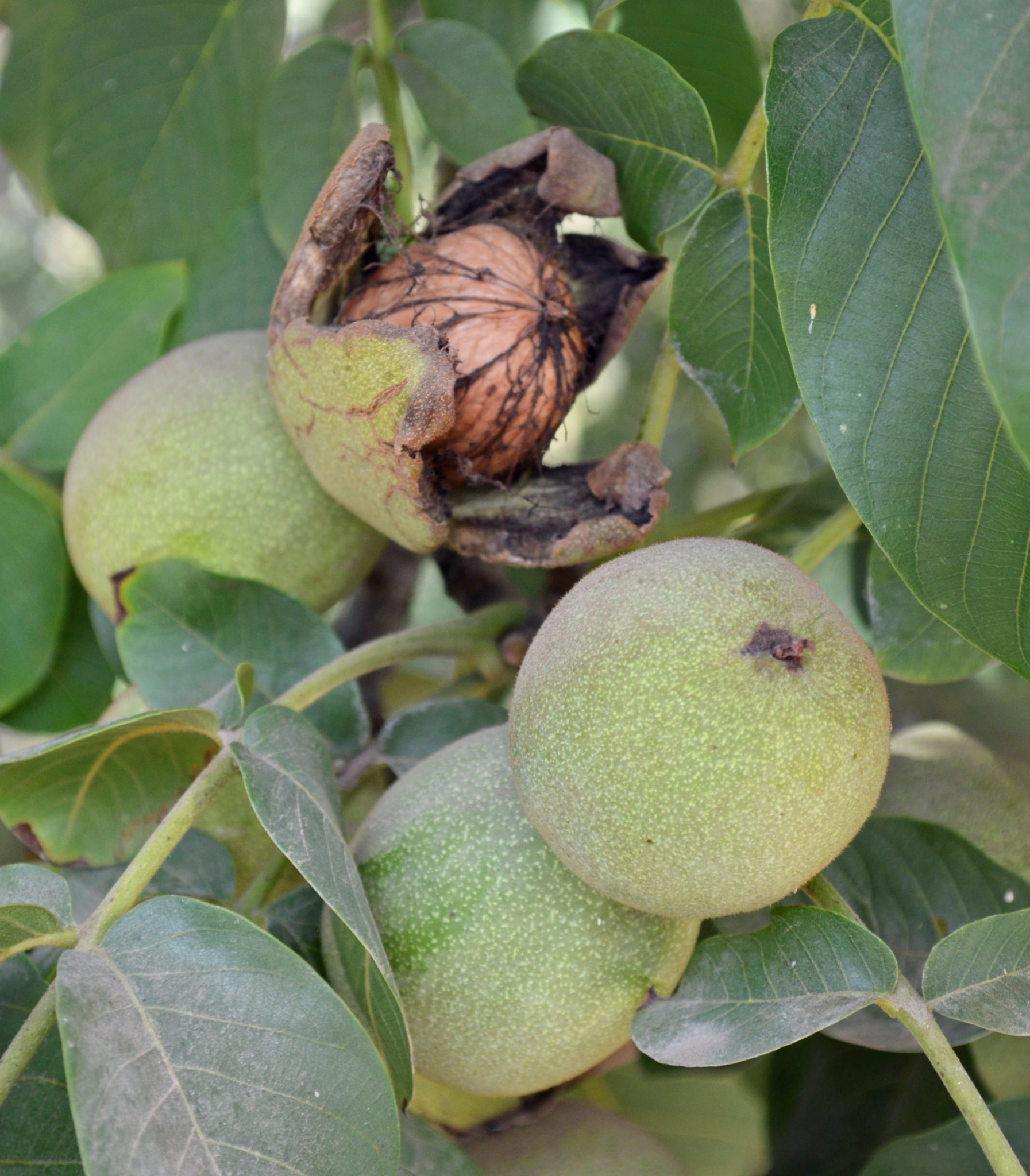
Improved Nut Removal
The other approach involves determining 95% PTB but waiting five to seven days to apply ethephon. This will hasten hull split, known scientifically as hull dehiscence, where the hull separates from the nut. In theory, this timing should promote a more uniform hull split and enhance nut removal during shaking. To make this option pay, he said growers need to obtain 95% or better nut removal with a single shake.
If you wait much longer to apply ethephon, you’re approaching the same harvest date as you would without a treatment. Because actual harvest timing will vary among orchards, variety, irrigation regime and growing region, Beede recommended growers experiment with shaking five, seven and 10 days after treatment.
A benefit of this approach is you’re leaving more hulls in the orchard, so you should have to haul fewer loads to the huller/drier. The huller/drier also should see improved hullability and more dryable product.
Mateo Marquez, a pest control adviser with Integral Ag Services in Durham, said most of the growers he works with who use ethephon apply it to increase harvest efficiency and recover more nuts during the first shake.
“Especially guys who have custom harvesting, they don’t want to have the harvester coming back a second time,” he said.
Some of Marquez’s growers who have larger acreage use ethephon to help space out harvest and reduce bottlenecks.
“Getting some blocks going earlier can help spread things out,” he said.
This year, Marquez said economics may come into play as growers decide whether to use the PGR. With low walnut prices, some may decide not to apply it as a cost-cutting move.
Year in and year out, Marquez said growers with Howard varieties tend to opt for ethephon. At maturity, the variety has a pellicle that tends to darken quickly after harvest.
“The earlier you can harvest them, the better color you have in the grade, so Howard’s seem to be the most targeted,” he said.
Getting the Most from Ethephon
Ethephon is a gas applied as a liquid formulation, and there’s only a certain amount of time – what Beede called hang time – before the product volatilizes. The goal is to apply it under conditions that will promote the longest hang time, such as spraying at night when humidity is higher or even during fog, he said.
“I don’t even care if it’s slightly drizzling because it is only increasing the hang time of the ethylene on the surface and optimizing the opportunity of absorption into the hull,” Beede said.
Ethephon does not translocate well within the hull, so coverage is the key. For application with an airblast sprayer, Beede recommends 4 to 5 pints of actual material applied in 150 to 200 gallons per acre. Adjuvants don’t seem to affect efficacy, said Beede, who conducted trials looking at different additives.
What does influence efficacy is the amount of ethephon applied, so 5 pints will likely provide improved results compared to 4 pints per acre, he said.
The product also can be applied by air following label recommendations, Beede said. Growers have reported good performance when applied in 20-40 gallons of water per acre, although some have reported premature defoliation of the tops of the trees.
How well varieties respond to ethephon depends on the porosity of the hull and the thickness of waxes on the hull surface, Beede said, citing research conducted by UC Davis plant physiologist Judy Jernstedt and her post-doctoral researcher, Michael Christianson.
Serr, for example, is not very responsive to ethephon because the hull isn’t very porous. Tulare, on the other hand, is very responsive and will literally fall off the tree shortly after treatment. Chandler is moderately responsive.
How well some of the newer varieties, such as Ivanhoe, Solano and Durham, respond is unknown, he said.
“We don’t know about any of those newer varieties other than from grower experience,” Beede said, expressing his frustration. “All of the new walnut varieties and the potential releases from the breeding program aren’t being tested for their preliminary responsiveness to ethephon using a dip test. The reason I was so adamant (about testing) is because the future goal of the walnut industry should be to eliminate the necessity for a second shake as much as we can. With the second shake, we’re harvesting walnuts that are overly mature, thus shortening their storage potential because walnuts are fraught with the problem of constant oxidation, darkened kernels and rancidity.”
For more information, download “The Art and Science of Ethephon Use on Walnuts” by Bob Beede at http://cekings.ucanr.edu.
